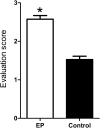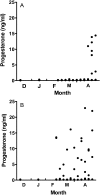Promoting effects of an extended photoperiod treatment on the condition of hair coats and gonadal function in Thoroughbred weanlings
- PMID: 26858581
- PMCID: PMC4739146
- DOI: 10.1294/jes.26.147
Promoting effects of an extended photoperiod treatment on the condition of hair coats and gonadal function in Thoroughbred weanlings
Abstract
The effects of an extended photoperiod (EP) treatment (14.5 hr light, 9.5 hr dark) on Thoroughbred colts and fillies from December 25 at 7-9 months old to the following May at 12-14 months old on coat condition and gonadal functions were investigated. Coat condition was evaluated in April. The colts and fillies in the EP treatment group changed from winter to summer coats (molting of winter coats), whereas those in the control group did not. To determine the day of first ovulation, the plasma concentrations of progesterone were measured once a month in fillies. The day of first ovulation was advanced in the EP treatment fillies compared with the control fillies. The present study clearly demonstrated that the EP treatment advanced the molting of winter coats and advanced ovulation in fillies, even in weanlings.
Keywords: Thoroughbred weanling; extended photoperiod treatment; gonadal function; molting of winter coat; progesterone.
Figures



Similar articles
-
Effects of an extended photoperiod on gonadal function and condition of hair coats in Thoroughbred colts and fillies.J Equine Sci. 2015;26(2):57-66. doi: 10.1294/jes.26.57. Epub 2015 Jul 2. J Equine Sci. 2015. PMID: 26170762 Free PMC article.
-
Different effects of an extended photoperiod treatment on growth, gonadal function, and condition of hair coats in Thoroughbred yearlings reared under different climate conditions.J Equine Sci. 2015;26(4):113-24. doi: 10.1294/jes.26.113. Epub 2016 Feb 3. J Equine Sci. 2015. PMID: 26858576 Free PMC article.
-
Comparison of growth and endocrine changes in Thoroughbred colts and fillies reared under different climate conditions.J Equine Sci. 2015;26(2):49-56. doi: 10.1294/jes.26.49. Epub 2015 Jul 2. J Equine Sci. 2015. PMID: 26170761 Free PMC article.
-
Effects of an extended photoperiod on body composition of young Thoroughbreds in training.J Vet Med Sci. 2024 Jan 10;86(1):58-65. doi: 10.1292/jvms.23-0349. Epub 2023 Nov 16. J Vet Med Sci. 2024. PMID: 37967974 Free PMC article.
-
Circulating pituitary and gonadal hormones in spring-born Thoroughbred fillies and colts from birth to puberty.J Reprod Dev. 2012;58(5):522-30. doi: 10.1262/jrd.2011-025. Epub 2012 May 19. J Reprod Dev. 2012. PMID: 22673032
Cited by
-
The Effect of Supplemental Lighting during the Late Gestation Period on Post-Partum Mechanical Properties of Mare and Foal Guard Hair.Vet Sci. 2024 Jan 22;11(1):49. doi: 10.3390/vetsci11010049. Vet Sci. 2024. PMID: 38275931 Free PMC article.
-
The Retinoic-Acid-Related Orphan Receptor Alpha May Be Highly Involved in the Regulation of Seasonal Hair Molting.Int J Mol Sci. 2025 Feb 13;26(4):1579. doi: 10.3390/ijms26041579. Int J Mol Sci. 2025. PMID: 40004044 Free PMC article.
-
Effects of different winter paddock management of Thoroughbred weanlings and yearlings in the cold region of Japan on physiological function, endocrine function and growth.J Vet Med Sci. 2024 Jul 2;86(7):756-768. doi: 10.1292/jvms.24-0083. Epub 2024 May 23. J Vet Med Sci. 2024. PMID: 38777756 Free PMC article.
References
-
- Allain D., Ravault J.P., Panaretto B.A., Rougeot J. 1986. Effects of pinealectomy on photoperiodic control of hair follicle activity in the Limousine ram: possible relationships with plasma prolactin levels. J. Pineal Res. 3: 25–32. - PubMed
-
- Brown-Douglas C.G., Firth E.C., Parkinson T.J., Fennessy P.F. 2004. Onset of puberty in pasture-raised Thoroughbreds born in southern hemisphere spring and autumn. Equine Vet. J. 36: 499–504. - PubMed
-
- Curlewis J.D., Loudon A.S.I., Milne J.A., McNeilly A.S. 1988. Effects of chronic long-acting bromocriptine treatment on liveweight, voluntary food intake, coat growth and breeding season in non-pregnant red deer hinds. J. Endocrinol. 119: 413–420. - PubMed
-
- Dhakal P., Hirama A., Nambo Y., Harada T., Sato F., Nagaoka K., Watanabe G., Taya K. 2012. Circulating pituitary and gonadal hormones in spring-born Thoroughbred fillies and colts from birth to puberty. J. Reprod. Dev. 58: 522–530. - PubMed
LinkOut - more resources
Full Text Sources
Other Literature Sources
Miscellaneous
